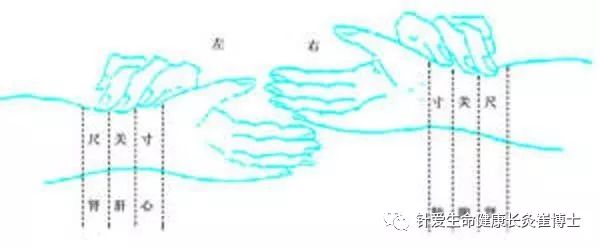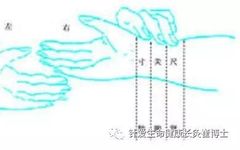In ancient times, there was a highly esteemed pulse diagnosis method known as the “Holding Pulse Weight Method” (持脉轻重法). This method was first introduced in the “Nanjing” (难经) and is also found in the “Pulse Classic” (脉经). After the Jin Dynasty, renowned physicians such as Sun Simiao from the Tang Dynasty and Zhu Donglong from the Ming Dynasty adopted this method. It is recorded in both the “Essential Prescriptions Worth a Thousand Gold” (千金要方) and “Four Seas Common Spring” (四海同春). The “Inner Canon” (内经) mentions that “pulses have weight and lightness” (脉有轻重), which refers to this diagnostic method.

The “Holding Pulse Weight Method” is very accurate for distinguishing between floating and sinking pulses. Its theoretical basis is the division of the cun (寸), guan (关), and chi (尺) positions into five parts. The specific operational method consists of three key steps:

First, place your fingers on the cun, guan, and chi positions. Then, apply pressure from the surface of the skin to the deepest point, ideally “pressing to the bone” (按之至骨). The term “pressing to the bone” describes a specific tactile sensation. It is characterized by the pulse qi (脉气) being unable to flow under the pressure, resulting in no pulse sensation felt beneath the fingers. If the fingers are slightly lifted, the pulse can be felt. The ancients referred to this as “pressing to the bone, lifting the fingers reveals the pulse” (按之至骨,举指来疾). This step primarily measures the depth of the cun position and the pressure applied. In practice, this depth is very important.
Second, divide the measured depth or applied pressure into five equal parts. Then, using these five divisions as a standard, re-pulse. If the cun pulse is in the upper two-fifths, it is a floating pulse; if it is in the middle one-fifth, it is a neither floating nor sinking pulse; if it is in the lower two-fifths, it is a sinking pulse. The application of pressure follows the same principle. First, define the pressure used at the deepest point as the total pressure. Then, re-pulse; if the pressure used does not exceed two-fifths to touch the cun pulse, it is a floating pulse. If the pressure exceeds two-fifths but does not exceed three-fifths, it is a neither floating nor sinking pulse. If the pressure exceeds three-fifths to touch the cun pulse, it is a sinking pulse.
Third, after mastering the division of depth and pressure, one can also discern the degree of floating and sinking pulses. Based on this, one can infer the progression of diseases. For example, in cases of external cold damage (外感伤寒), if the pulse is floating, and after treatment, the degree of floating does not decrease, it indicates that the exterior pathogen has not been eliminated; if the pulse changes from floating to neither floating nor sinking, it indicates that the exterior pathogen has been eliminated and the righteous qi (正气) has returned. If the pulse changes from floating to sinking, and the degree of sinking is significant, one should carefully investigate whether the exterior pathogen has entered the interior.

Often, many people believe that “lifting is excessive, pressing is insufficient” (举之有余、按之不足) indicates a floating pulse, while “pressing is excessive, lifting is insufficient” (按之有余、举之不足) indicates a sinking pulse. Or they think that a slight press indicates a floating pulse, while a heavy press indicates a sinking pulse. In reality, between floating and sinking pulses, there is also a neither floating nor sinking pulse, and using the above two methods makes it difficult to distinguish between floating, sinking, and neither floating nor sinking pulses. Additionally, there is the hidden pulse (伏脉), which is even harder to distinguish from the sinking pulse. However, using the Holding Pulse Weight Method, it is easy to differentiate between the hidden pulse and the sinking pulse.!?
Besides the aforementioned points, the Holding Pulse Weight Method has many other advantages, with both theoretical basis and operational norms, making it very simple and easy to master, and particularly practical in clinical settings. Those interested may want to give it a try.
|
I Copyright Statement: Respect knowledge and labor; please retain copyright information when reprinting. The copyright of the content published on this platform belongs to the relevant rights holders. If there are any improper uses, please feel free to contact us for negotiation. I Submission and cooperation email: [email protected] |
Recommended Excellent TCM Public WeChat Professional Platform

Long press the QR code above to follow, “National TCM Development Cooperation Information Sharing Platform”
Public account ID: zyjyccbk
Long press the QR code above to follow, “Treasures of Experience Transmission from Renowned Old TCM Doctors” is welcome!
For cooperation and communication, please add WeChat ID:1064726688


